Guide to SAT Punctuation Rules + Practice Questions
Having a strong command of punctuation will not only help you while taking the actual SAT, but will enhance your writing skills in general, preparing you for any essays you may need to write throughout the college admissions process. In this post, we’ll cover the different types of punctuation you’ll need to know for the SAT and work through some difficult practice questions. The SAT Writing & Language Test is the second section of the SAT, and your score for this section combines with your score for the SAT Reading Test, constituting your total Evidence-Based Reading and Writing (EBRW) score, which is out of 800. In total, the test consists of 44 questions to be completed in 35 minutes. Questions fall into a variety of categories: Punctuation questions fall into the last category, and the SAT Writing & Language Test usually contains around 5-7 of these types of questions. So, having these punctuation rules memorized and readily available will allow you to quickly answer those punctuation questions correctly. Here are some of the most important punctuation rules that you should know for the SAT Writing & Language Test, along with sample SAT questions and explanations. Before we dive right into the punctuation, let’s first establish the difference between independent and dependent clauses. A clause is a group of words containing a subject and a predicate. An independent clause is a clause that can stand alone as a sentence. A dependent clause is a clause that can’t stand alone as a sentence. Example: Because of the weather, you should wear a jacket. This could stand alone as a sentence. This could not stand alone as a sentence. Knowing how to identify independent and dependent clauses is important because it will guide you when choosing the appropriate punctuation. The SAT Writing & Language Test expects you to be familiar with comma usage. Commas are a particularly tricky form of punctuation since they have many distinct uses. Appositives Appositives are tested quite often on the SAT, so it’s a good idea to familiarize yourself with what they are and how they show up on the test. Appositives are clauses that follow a noun or noun phrase in order to further clarify or add information about them – think of them as little add-on helpers or supporters in sentences. The helpers add to the sentence but don’t necessarily need to be a part of it. That is, the sentence doesn’t lose its structure or meaning in their absence. Here are some examples: (For each sentence, the appositive is bolded.) If you were to see either of these appositives without commas, the sentence would be grammatically incorrect as their inclusion is not integral to keep the sentence intact. So if you see sentences lacking commas on either side of the appositive, they’re incorrect. Here are some examples of grammatically incorrect sentences: These can be really simple mistakes to catch – or miss – so make sure you’re reading the sentences as closely as possible to ensure that you get those “gimme” points. Here is a sample question with an appositive: Answer: C For this question, the appositive is “an associate professor of geology at Ohio State.” This appositive should be surrounded by commas on either side, so C is the correct answer. Restrictive Clauses Restrictive clauses are like appositives, but the difference is they contain verbs in the clauses. These can be a bit tricker to parse out when you’re completing the writing section of the SAT. So, make sure to slow down and read the sentence in its entirety. Only include commas for nonrestrictive clauses, which refer to phrases in sentences whose inclusion does not alter the meaning of the sentence. For example: Jimi, who plays soccer, goes on runs four times a week. If you remove the phrase “who plays soccer,” you’re left with a sentence that still makes sense on its own. Therefore, this clause can afford to be put into commas. Now, let’s look at the reverse, with a restrictive clause. Restrictive clauses are the opposite, where their inclusion is instrumental in the sentence, to the point where it doesn’t make sense without it. For example: People who run need to drink water often. If you were to punctuate this as “People, who run, need to drink water often,” you’d be insinuating that “People need to drink water often” has the same meaning, as the sentence is semantically the same with or without the clause. But here, this is not the case. Therefore, commas around this clause would be grammatically incorrect. Coordinating conjunctions Another important use of the comma is with FANBOYS. This is a useful mnemonic for the coordinating conjunctions: for, and, nor, but, or, yet and so. A comma, followed by a coordinating conjunction, can be used to join two independent clauses. For example: Belinda’s favorite ice cream flavor is coffee, and her sister’s favorite is mint chip. This sentence contains two independent clauses: Because these two independent clauses are joined by a comma and a coordinating conjunction (“, and”), the sentence is grammatically correct. If you leave off the coordinating conjunction, the result is a comma splice: “Belinda’s favorite ice cream flavor is coffee, her sister’s favorite is mint chip.” A comma cannot join two independent clauses by itself, so watch out for comma splices on the SAT. Here is a sample SAT question: Answer: B For this sentence a coordinating conjunction wouldn’t be used since the first clause (“Because consumers reap the nutritional benefits of Greek yogurt and support those who make and sell it”) is dependent. For this same reason, a colon can’t be used. So, choices C and D are incorrect. Also, answer choice A is incorrect: the “therefore” is redundant since the sentence starts with “because.” Then, choice B is the only remaining option and is correct because it joins a dependent and independent clause with a comma. [amp-cta id="9459"] Semicolons are primarily used to join two independent clauses. Usually, the two independent clauses are related, and the second emphasizes, clarifies, or follows from the first. Unlike commas, semicolons don’t need to be used with a coordinating conjunction. For example: Reya enjoys playing sports; her favorite is basketball. Most often, the SAT tests your knowledge of semicolon use by using it incorrectly. For example: Reya enjoys playing sports; because her favorite is basketball. In this case, the use of a semicolon is incorrect since the clause after the semicolon is dependent. This sample SAT question illustrates common mistakes with semicolons: Answer: C For this statement, a semicolon would not be grammatically correct–the clause before the semicolon, “in the years that followed,” is not independent, so a semicolon wouldn’t be appropriate. Therefore, the correct choice in this situation would be a comma. The first and foremost rule is that a colon must be preceded by an independent clause. Like commas, colons have multiple uses: Here are some examples of grammatically correct sentences with colons: This question involves colons: Answer: C For this question, the clause before the punctuation, “But Jason Box, an associate professor of geology at Ohio State believes that another factor added to the early thaw,” is an independent clause. This means we can use a colon. Also, a colon is appropriate in this situation since the clause after, “the ‘dark snow’ problem,” elaborates on the “another factor” mentioned in the preceding clause. Dashes have two main functions. Like commas, they can be used with appositives, and like colons, they can be used for emphasis or explanation. For example: The children–dressed in matching overalls–smiled brightly for the family photo. The clown always wears red shoes before going on stage–they’re her good luck charm. Here is an SAT question involving dashes: Answer: C In this case, the function of the dashes is to surround the appositive, “originally thought to exist only around an undersea volcano near Hawaii.” Because a dash is used at the beginning of the appositive, a dash should also be used at the end, for continuity. Therefore, the correct answer is C. Most colleges use a statistic called the Academic Index (AI). Your AI is calculated by taking into account your GPA and standardized test scores, including your SAT score. Though this has changed during the COVID-19 pandemic, some selective colleges reject applications with an AI that’s too low. To see how your SAT score compares to other applicants, check out CollegeVine’s free Admissions Calculator, which will not only tell you your chances at various colleges, but offer insight on what other aspects of your profile can be improved!
What’s Covered:
Overview of SAT Writing & Language Section
SAT Punctuation Rules
Clauses
Commas
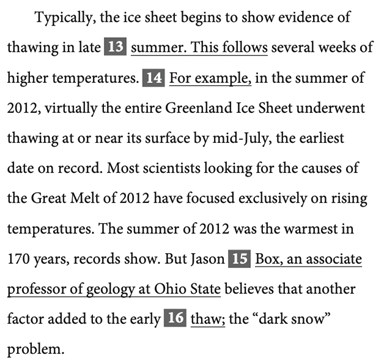
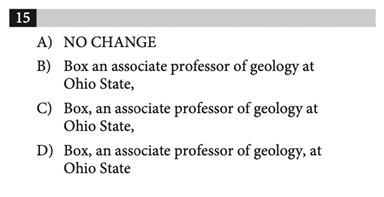
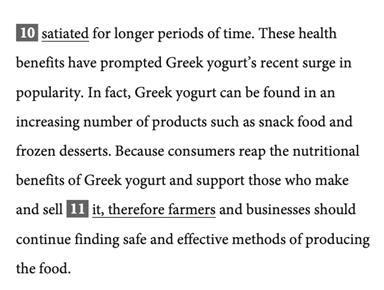
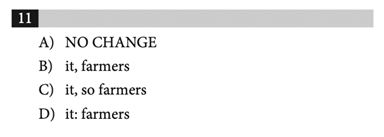

Semicolons
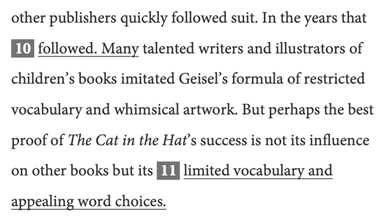
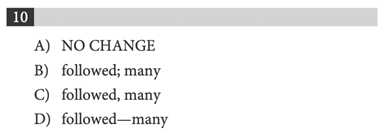
Colons
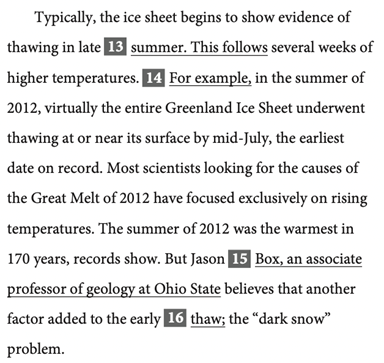
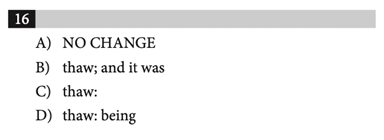
Dashes

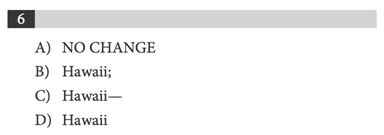
How Will My SAT Score Impact My College Chances?




